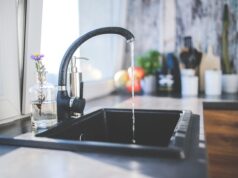Contents
From Clogs to Leaks: How to Fix Your Kitchen Sink Drain Like a Pro
Are you tired of dealing with a clogged or leaking kitchen sink drain? Don’t worry, you’re not alone! Many homeowners face this frustrating plumbing issue at some point. But, the good news is that you don’t always have to call a professional plumber for help. With a few simple tools and techniques, you can fix your kitchen sink drain like a pro.
Some of the common reasons why your kitchen sink drain is clogged or leaking include accumulated food debris, soap scum, grease buildup, or damaged pipes. To fix these issues, you will need some basic plumbing tools such as a plunger, a pipe wrench, and a drain snake.
First, try using a plunger to remove any blockages in the drain. If this doesn’t work, you may need to use a drain snake to manually remove the debris. Additionally, inspect the pipes for any signs of leaks or damage. If you find any, use a pipe wrench to tighten or replace the damaged part.
By following these simple steps, you can fix your kitchen sink drain and save money on plumbing services. So, next time you face a clogged or leaking kitchen sink drain, don’t panic. Remember, with the right tools and techniques, you can tackle this plumbing issue like a pro!
Identifying the Problem
Before you can fix your kitchen sink drain, you need to identify the source of the problem. Is your sink clogged or leaking?
Clogged Sink Drain
If your sink is clogged, you can use a plunger or a drain snake to try and remove the blockage. You can also try pouring a mixture of baking soda and vinegar down the drain to help loosen the clog. If none of these methods work, you may need to take apart the drain and manually remove the blockage.
Leaking Sink Drain
If your sink is leaking, you may need to replace the gasket or the entire drain assembly. This requires some plumbing knowledge and tools, so if you’re not comfortable with DIY plumbing, it might be best to hire a professional.
Gathering Your Materials
Once you’ve identified the problem, you’ll need to gather the necessary materials to fix your kitchen sink drain. Here are some common tools you’ll need:
- Adjustable wrench
- Channel lock pliers
- Hacksaw or reciprocating saw
- Plumber’s putty
- Silicone caulk
Depending on the specific issue, you may need additional materials such as a new gasket, drain assembly, or PVC cement.
Fixing Your Kitchen Sink Drain
Now that you have your materials, it’s time to fix your kitchen sink drain. Here are some basic steps to follow:
1. Turn Off the Water
Before you begin any plumbing work, turn off the water supply to your sink. This can usually be done by turning off the valves under the sink or shutting off the main water supply.
2. Remove the Drain Plug
If your sink has a removable drain plug, unscrew it and remove it from the sink. This will allow you to access the drain assembly beneath the sink.
3. Loosen the Slip Nuts
Using your channel lock pliers, loosen the slip nuts that hold the drain assembly in place. Be sure to place a bucket or container under the sink to catch any water that may spill out.
4. Remove the Drain Assembly
Carefully remove the drain assembly from the sink. Inspect the gasket for any damage and replace it if necessary.
5. Install the New Drain Assembly
If you’re replacing the entire drain assembly, follow the manufacturer’s instructions for installation. If you’re only replacing the gasket, apply plumber’s putty around the bottom of the assembly and carefully place it back into the sink.
6. Reconnect the Slip Nuts
Tighten the slip nuts back into place using your channel lock pliers. Be careful not to overtighten them, as this can cause damage to the drain assembly and lead to leaks.
7. Apply Silicone Caulk
If necessary, apply a small amount of silicone caulk around the rim of the drain assembly to create a watertight seal.
8. Reattach the Drain Plug
Finally, screw the drain plug back into place and turn on the water supply. Test your sink to make sure the drain is working properly and that there are no leaks.
Conclusion
Fixing your kitchen sink drain may seem daunting, but with the right tools and some basic plumbing knowledge, you can tackle the job like a pro. If you’re not comfortable with DIY plumbing, don’t hesitate to seek the help of a professional plumber. A properly functioning sink drain is essential to keeping your kitchen clean and functional.
For more information on plumbing and home repair, check out Family Handyman.
FAQs
What is From Clogs to Leaks: How to Fix Your Kitchen Sink Drain Like a Pro?
From Clogs to Leaks is an informational article that provides tips and strategies for fixing kitchen sink drains. It covers common problems like clogs and leaks and gives advice on how to identify and fix these issues like a pro.
Why is my kitchen sink drain clogged?
Kitchen sink drains can become clogged due to a variety of reasons such as food particles, grease, and soap scum. These substances can build up in the drain and cause a blockage. In some cases, a clogged drain could indicate a more serious problem like a blocked vent pipe or sewer line.
How can I prevent future clogs?
To prevent future clogs in your kitchen sink drain, avoid dumping grease and fat down the drain, use a drain strainer to catch food particles and dispose of them properly, and regularly clean and flush the drain with hot water and baking soda or vinegar.
What if I can’t fix my kitchen sink drain?
If you are unable to fix your kitchen sink drain on your own, it may be time to call a plumber. A plumbing professional has the necessary tools and expertise to identify and fix more complex problems like damaged pipes or blockages deep in the plumbing system.
Is your Kitchen Sink’s Drain Plug Giving You Trouble?
Possible Reasons for a Malfunctioned Kitchen Sink Drain Plug
Have you ever found yourself staring at the kitchen sink’s drain, scratching your head as to why it’s not draining properly? You may find yourself wondering, “how do I fix the kitchen sink drain plug?” In this article, we’ll review some of the reasons why your kitchen sink drain plug may not be functioning properly.
- The drain plug is not properly seated into the drain
- The drain plug’s gasket is missing or cracked
- The drain is clogged with debris or grease
- The linkage that lifts the drain plug is broken or disconnected
There are a few ways to troubleshoot and repair any of these problems yourself, with a little bit of elbow grease and patience. If you’re inexperienced or unsure, it may be helpful to reach out to a professional for assistance.
Simple Solutions to Fix Your Kitchen Sink Drain Plug
If the issue is that the drain plug is not properly seated into the drain, try cleaning the underside of the plug and the drain itself. Using a needle-nose pliers or a flat screwdriver, gently straighten any bent or damaged parts. Once the plug fits more tightly into the drain, it should seal and open smoothly.
If the issue is a missing or cracked gasket, you may be able to find a replacement at a local hardware store or purchase one online. Be sure to identify what kind of drain plug you have, including the size and shape, so that you buy the right kind of gasket for your specific drain.
If the drain is clogged, try using a plunger or a mixture of baking soda and vinegar. This can help to break down any grease or debris that has accumulated in the drain. If these methods don’t work, consider purchasing a drain snake or calling a plumber.
If the linkage that lifts the drain plug is broken or disconnected, you’ll need to access it by removing the drain plug. Once you’ve removed the plug, inspect the linkage for any damage or missing parts. If you find that a part is missing, check with your local hardware store or purchase the replacement part online. If the linkage is too damaged to fix on your own, contact a plumber for assistance.
As you can see, there are a number of reasons why your kitchen sink drain plug may not be functioning properly. With a little bit of troubleshooting and some elbow grease, you can likely fix the problem yourself. If you’re hesitant or unsure of your abilities, feel free to contact a professional for assistance.
For more information about kitchen sink drains, please visit Wikipedia.
From Clogs to Leaks: How to Fix Your Kitchen Sink Drain Like a Pro
Introduction
- Why it’s important to know how to fix your kitchen sink drain
- Common issues you might face
- Tools you’ll need
Identifying the Problem
- How to determine if it’s a clog or a leak
- Common causes of clogs and leaks
- How to locate the source of the problem
Unclogging Your Drain
- Using a plunger
- Using a drain snake
- Using a DIY mixture to dissolve clogs
- Preventative measures to avoid future clogs
Fixing Leaks
- Identifying different types of leaks
- Fixing leaks in different parts of the drain
- Replacing damaged or worn out parts
- Preventative measures to avoid future leaks
Conclusion
- Recap of key takeaways
- Tips for maintaining a healthy kitchen sink drain
- When to call in a professional


































